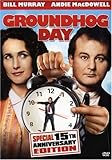Last December the New York Times ran an intriguing article about a Museum of Modern Art movie series on film and faith. What attracted the Times to the series was not its pageant of grave Swedish cinema but its opening feature, the 1993 romantic comedy Groundhog Day. The curators, polling “critics in the literary, religious and film worlds,” found that the movie “came up so many times that there was actually a squabble over who would write about it in the retrospective’s catalog.”
The movie, the article went on to observe, “has become a curious favorite of religious leaders of many faiths, who all see in Groundhog Day a reflection of their own spiritual messages.” A professor at NYU shows it in her classes to illustrate the doctrine of samsara (the endless cycle of rebirth Buddhists seek to escape), while a rabbi in Greenwich Village sees the film as hinging on mitvahs (good deeds). Wiccans like it because February 2nd is one of the year’s four “great sabbats,” while the Falun Dafa sect uses the movie as a lesson in spiritual advancement.
Deciphering which, if any, of these interpretations is correct is no easy task, especially since the director and co-writer of the film, Harold Ramis, has ambiguous religious beliefs (he is an agnostic raised Jewish and married to a Buddhist). The commentators also seem wedded to a single hermeneutical lens, forcing them to ignore contradictory data.
A more fruitful approach, I suggest, would involve following all of the clues, clues that lead not only to religion but also to the great conversation of philosophy. Once we do so, Groundhog Day may be seen for what it is: a stunning allegory of moral, intellectual, and even religious excellence in the face of postmodern decay, a sort of Christian-Aristotelian Pilgrim’s Progress for those lost in the contemporary cosmos.
Read the whole thing! – Touchstone Archives: Phil’s Shadow.
